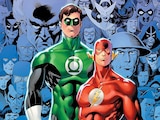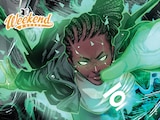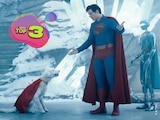The recent debut of the new Metamorpho series by Al Ewing and Steve Lieber has got us in an…elementary sort of mood. Traditionally, the elemental hero Rex Mason has the power to transmute himself into any form of any element in the human body—primarily, oxygen, carbon, hydrogen, nitrogen, calcium and phosphorus. But as time has gone on, Metamorpho’s powers have only gotten greater. Today, as often as not, Metamorpho commands the ability to transmute himself into any element in the universe.
Think about that, though. The DC Universe’s periodic table is a lot more extensive than the one in our own universe. Just how powerful can Metamorpho really become? To figure that out, we’ve assembled a collection of elements and compounds exclusive to the DC Universe, along with their known properties, ordered by year of discovery. Prepare your electron microscopes.

Nth Metal (Flash Comics #1, 1940): Also "ninth metal," with gravity-affecting, anti-magic and other significant properties most famously used by Hawkman and Hawkgirl. An Nth Metal alloy, Valorium, is used in the Legion of Super-Heroes’ flight rings.
Kryptonite (Adventures of Superman, “The Meteor from Krypton,” 1943): Mineral with many variants which affect Superman and others in a variety of ways, formed from irradiated remains of the planet Krypton. Variants include:
- Anti-Kryptonite – Lethal to Kryptonians unexposed to yellow solar energy.
- Black Kryptonite – Drives Kryptonians into a killing frenzy, or splits them into morally diametric doubles.
- Blue Kryptonite – Usually has the same effect on Bizarro clones as Green Kryptonite has on Kryptonians. Sometimes bestows Bizarros with enhanced intelligence.
- Gold Kryptonite – Permanently disables a Kryptonian’s powers.
- Green Kryptonite – Weakens and, upon prolonged exposure, kills Kryptonians.
- Jewel Kryptonite – Allows Kryptonians to focus their thoughts into telepathic abilities.
- Meta-Nite – Similar to Green Kryptonite on Earth-23.
- Platinum Kryptonite – Permanently grants Kryptonian abilities to a non-Kryptonian.
- Red Kryptonite – Randomized, unpredictable effects on Kryptonians, usually for 48 hours.
- White Kryptonite – Kills plant life.
- X-Kryptonite – Similar to Platinum Kryptonite. Originally responsible for empowering Streaky the Super Cat.

Protium (The Marvel Family #10, 1947): Ancient element rediscovered by Dr. Sivana to negate Captain Marvel's powers. Unrelated to real world protium.
Sivanium (Captain Marvel Adventures #100, 1949): A "living metal" developed by Dr. Sivana to make sentient robots. Said to be element 97.
Shazamium (Captain Marvel Adventures #100, 1949): The element which formed a bracelet that allowed the Wizard Shazam to materialize in the Rock of Eternity. Said to be element 98.
Marvelium (Captain Marvel Adventures #100, 1949): An extremely strong metal created by Captain Marvel. Said to be element 99.
Amazonium (Sensation Comics #89, 1949): The metal from which Pre-Crisis Wonder Woman's bracelets, tiara and lasso was made. Also called “Feminum” in the Wonder Woman TV series.

Supermanium (World’s Finest Comics #41, 1949): Indestructible material formed from the heart of a star by Superman.
Zonium (Blackhawk #75, 1954): An explosive component of "Element Z," a billion times more destructive than the hydrogen bomb. Neutralized by the Blackhawk Squadron when they discover it's rendered inert by strong heat.
Amnesium (Superboy #55, 1957): Alien mineral that affects memory.
Illium 349 (Action Comics #245, 1958): Rare element used in enlarging rays developed by Kandorian scientists.
Xium (Action Comics #257, 1959): Element discovered by Lex Luthor which gave humans powers similar to Kryptonians. Superman tricked Luthor into destroying all of it by convincing him of a fake side effect that made anyone subjected to it impulsively give up all their money.
Dilustel (Space Adventures #33, 1960): The multidimensional metallic substance grafted onto Captain Atom.
Vaxxium (Superboy #83, 1960): Element used by Jor-El to defy gravity.

White Dwarf Star Fragment (Showcase #34, 1961): A material of unknown composition used in the Atom's shrinking powers.
M-Metal (The Flash #128, 1962): Metal used in the 64th century to facilitate time travel, utilized by Abra Kadabra.
Kryptylium (Superboy #104, 1963): Highly magnetic metal found on the planet Krypton before its destruction.
Cavorite (The Atom #10, 1964): Fictional gravity-defying material from HG Wells' “The First Men in the Moon,” which the Atom discovers is real.
Cancellite (Adventure Comics #326, 1964): Compound invented by Supergirl that negates Durlan shapeshifting powers.
Zuunium (Adventure Comics #327, 1964): Element found only on the planet Zoon which gave the Legionnaire Timber Wolf his powers.
Inertron (Adventure Comics #336, 1965): Indestructible metal used in the 30th century, and in Deathstroke's 2016 Ikon suit.

Kryptium (Action Comics #329, 1965): Extremely hard metal found on Krypton before its destruction.
Staggium (Metamorpho #3, 1965): Material derived from a meteorite that weakens Metamorpho.
Sunstone (Action Comics #336, 1966): Crystal from which the Fortress of Solitude was formed.
Plastalloy (Justice League of America #45, 1966): Source of the transformation of the Justice League villain Shaggy Man.
Absorbium (Action Comics #343, 1966): Weak radioactive element found in the center of the Earth; weakness to Eterno the Immortal and Lightning Lass.
Uritrium (Aquaman #39, 1968): A fatal element to Venusians.
Pyro-Granulate (Superman’s Pal, Jimmy Olsen #139, 1971): An artificial mineral from Apokolips which ignites a body within 24 hours when ingested.

Radion (The Forever People #1, 1971): Lethal element to the New Gods.
Trolium (Superman #243, 1971): Highly radioactive element from Krypton before its destruction.
Element X (The New Gods #7, 1972): Material from which the technology of Fourth World is made, including the Mother Box.
Stellarium (Superman #257, 1972): A material which could have potentially stabilized Krypton's core. The Green Lantern Tomar-Re attempted to use it, but failed to make it in time.
Suspendium (Shazam! #1, 1973): Used by Dr. Sivana to suspend the Marvel Family in time.
Lafargium (World’s Finest Comics #229, 1975): Material from which the "Strangler from the Stars" generated. Also called "Staggium."
Promethium (The New Teen Titans #9, 1981): Alloy created by Steve Dayton originally used in Cyborg's body and Deathstroke's equipment.

Orichalcum (Arion, Lord of Atlantis #4, 1983): Mineral with magical properties used by Arion, Lord of Atlantis, Felix Faust and other magic users, and sought after by Black Manta in Aquaman and the Lost Kingdom.
Eternium (The Legion of Super-Heroes #110, 1998): Shards of the destroyed Rock of Eternity in the distant future used to negate the power of Shazam.
Smartskin (Seven Soldiers: Bulleteer #1, 2006): Indestructible metal bonded to Bulleteer's skin.
Tellurium (Green Lantern Corps #11, 2007): Used on other planets to convert mental energy into heat.
Quixium (Terra #1, 2009): Metallic element used by the subterranean Stratans to alter genetic properties and create superheroes.

Electrum (Batman #2, 2011): Metal used to reanimate the Talons in the Court of Owls. Likely no connection to real world electrum.
Earthstone (Superman Unchained #3, 2013): A rare mineral compound essential in advancing future technology.
Dionesium (Batman #40, 2015): The liquid metal that gives the Lazarus Pits their potency.
Batmanium (Batman #45, 2015): Extremely dense metal that can be a liquid or a solid at room temperature.
Eighth Metal (Dark Days: The Casting #1, 2017): The divine metal used to form the weapons and armory of the gods.
Genesis (Action Comics #1031, 2021): The crystallized blood of the Old God Olgrun and a powerful energy source.

Those are all the rare comic elements we could scare up. But if the DC Universe has taught us anything, it’s that there’s always yet more unknown to be discovered. What strange new materials will Metamorpho expose us to in the issues to come? Not even the Element Man knows for sure—but we’re certain he’s ready to find out.
Alex Jaffe is the author of our monthly "Ask the Question" column and writes about TV, movies, comics and superhero history for DC.com. Follow him on Bluesky at @AlexJaffe and find him in the DC Official Discord server as HubCityQuestion.
NOTE: The views and opinions expressed in this feature are solely those of Alex Jaffe and the winning voters who took part in the DC Official Discord survey and do not necessarily reflect those of DC or Warner Bros. Discovery, nor should they be read as confirmation or denial of future DC plans.















